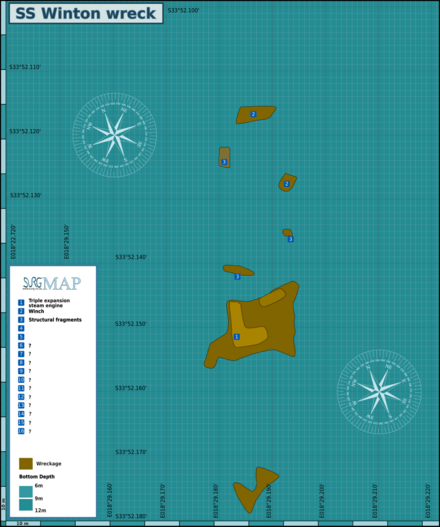Diving the Cape Peninsula and False Bay/MV Winton
Diving the Cape Peninsula and False Bay/MV Winton
The dive site MV Winton is an inshore recent wreck in the Milnerton beach area of Table Bay, near Cape Town in the Western Cape province of South Africa.
Understand
 See also: Diving the Cape Peninsula and False Bay#Understand
See also: Diving the Cape Peninsula and False Bay#Understand
A shallow wreck site on a sand bottom, within swimming distance of the beach.
Position
SS Winton 📍: S33°52.1514' E18°29.1828'
This site is not in a Marine Protected Area. A permit is not required.
Name
The name "Winton" is the name of the ship wrecked at the site.
Depth
Maximum depth is about 6 m, and the top of the engine block is about 3 m. Average depth of a dive is likely to be about 5 m.
Visibility
The wreck is close inshore on a fine sand bottom, and visibility is seldom more than 3 to 5 m, as there is almost always some surge, even on very flat days
Topography
The wreck is very broken up, and quite a lot may be buried in the sand. There are occasional bits of structure and heavy machinery that still project above the sand and can be visited by divers. The bottom is flat and except for the wreckage, virtually featureless. Small sand ripples indicate the swell direction, and help with navigating between the pieces of wreckage, which are generally too far apart to see from one to the other. The wreck lies parallel to the shoreline, so the sand ripples are often in line with the long axis of the wreck.
Geology: Fine sand bottom, level and featureless, approximately constant depth but with slight scour depressions at large bits of wreckage.
Conditions
The site is exposed to winds from any direction, and waves from the west and north-west, so should be dived in easterly winds or a calm, with no westerly swell, and is most likely to be diveable in summer, during or after south easterly winds. The site is reasonably protected from south-westerly swell.
Get in
See also: Diving the Cape Peninsula and False Bay#Boat dives
Usual access: Boat dive from Oceana Power Boat Club slipway or the V&A Waterfront or shore dive from Milnerton beach.
See
Marine life
See also: Diving the Cape Peninsula and False Bay#The marine ecology
The wreck is in quite a high energy zone in winter, and will be pounded by winter storms. That does not stop considerable biodiversity on the equivalent rocky reefs, but for some reason the wreckage has very low biodiversity. Sme barnacles, a small amount of seaweeds, anemones, the occasional klipfish, and some orange-clubbed nudibranchs have been recorded.
Features
Scattered fragments of wreckage of a steel ship, including the engine block and some associated machinery, and a couple of winches.
Photography
Not a good site for photography due to the generally poor visibility and low biodiversity.
Suggested routes
Start at the engine block, which is the most interesting feature, then swim north or south and if lucky you will find other fragments. The map may be helpful to plan a route.
Stay safe
See also: Diving the Cape Peninsula and False Bay#Stay safe
Hazards
There are some large, sharp pieces of steel plating and frames projecting out from the sand which could injure a diver it the surge is strong.
Skills
No special skills needed, but good compass navigation will help if you want to visit all the bits.
Equipment
See also: Diving the Cape Peninsula and False Bay#Equipment
No special equipment needed.
Nearby
- MV Afrikaner 📍
- Highfields 📍
- Two Oceans Aquarium 📍
- SS Cape Matapan 📍
- RMS Athens 📍
- SS SA Seafarer 📍
- Three Anchor Bay 📍
- Sea Point Ridge Pinnacles 📍
Back to the Alphabetical list of sites, or list of dive sites in the Table Bay area
Other regional dive sites: